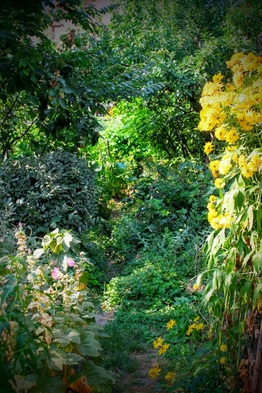Week 20 - Butterfly Polyculture and Grandmother's interview
The week was quite rainy so we were most of the time in inside. Mostly collecting seeds, sorting them and creating a seed library.
Our dear artist team member Ruxandra designed an amazing Butterfly Polyculture. We are planning and creating a butterfly polyculture area in Shipka garden. We choose these plants; Buddleia davidii - Butterfly bush, Phlomis russeliana - Turkish Sage, Lavandula angastafolia - Lavender, Origanum vulgare - Oregano and Echinacea purpurea - Echinacea.
Polycultures are two or more useful plants grown on the same plot, usually at the same time. From an ecological perspective, they try to mimic natural cycles. Like natural systems, they offer benefits, including reduced pest damage and soil conservation, even increasing crop yields per area compared to monocultures. In an ecosystem diversity bring stability.
Butterfly Polyculture's main function is attracting butterflies and wildlife. All the species can tolerate drought.
Buddleia davidii - Butterfly bush
Deciduous shrub. It blooms from July-October. It blooms amazing little purple flowers. It attracts butterflies.
Phlomis russeliana - Jeruselum/Turkish Sage
Evergreen shrub. It blooms from May-September. It has gorgeous yellow flower.
Lavandula angastafolia - Lavender
Evergreen shrub. It blooms from July-August, attracting wildlife. It has little pure purple flowers.
Echinacea purpurea - Echinacea, Coneflower
Perennial. It blooms from July-August. It has beautiful characteristical pink and yellow flowers. It is attracting wildlife.
Origanum vulgare - Oregano
Perennial. It blooms from July-October. The blooms are small, delicate and purple and attract incredible intrest to butterflies.
Beginning of the week, we collected some jeruselam artichokes from Baba Vasilika's garden. Turned the compost, weeded quite much lawn grasses and made an interview with her and. Baba (Grandmother) Vasilika has a lot knowledge about gardening, raising and grazing animals. She had over 100 sheeps. Her daily routine was waking around 4 o'clock taking care of animals and also she was working full time. Determination, family, love and other knowledgable grandmothers gave inspiration her a lot.
Nursery orders are quite much because the Balkan Ecology Project and team are giving so much care and love. It's amazing to deal with plants and trees. :)

Also most of the people when they are buying plants just looking leaves and branches. Root system of plant is crucial to look at it. Knowing the health of your plants’ roots can dramatically improve its vigor. For example: if you are recognizing odd foliage problems such as leaf drop or discoloration, or your plant just seems to lack vigor, be sure to first take a peek at the root structure. You simply turn the plant on its side, tap the entire root ball out of the pot and examine the color of the roots. If they are soft, brown and easily fall apart when you touch or pull on them, you can be assured that some or all of the root system has collapsed. If the roots are white or tan colored, succulent when you pull on them and have fleshy white tips, then your root system is healthy.
Left root is unhealthy, right root is healthy.
With more air in the soil the roots can “breathe” better, this lessens the chance for fungi to grow. That is where the term “an open and well-drained potting mix” comes from. The amount of water and fertilizer is directly related to maintaining healthy roots. When it is time to water your plant, water thoroughly by letting a little water run out of the bottom of the pot. When a plant goes into its winter rest (or slower growth period) do not over fertilize; in most cases you should stop feeding all together.
At this weekend we went UFO-shaped Buzludzha monument. The monument is recognised as one of Europe's most
endangered heritage sites. The monument of Buzludja stands on a peak rising to 1,441 m and dominating the pass. Going up to the site, you will see a steel monument representing two fists holding torches. Next to the building, a tall concrete structure points skyward, a red star adorning its top. Rumors that the star was made of ruby (it's actually glass) prompted locals to loot and damage the site.
Stay tuned more,
Brought to you by Ruhsar





Comments
Post a Comment